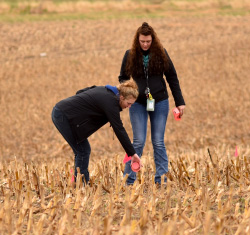NORFOLK, NE – The benefits of cover crops are numerous. The USDA’s Natural Resource Conservation Service reports they prevent erosion, improve physical and biological properties of soil, supply nutrients, suppress weeds, improve the availability of soil water, and break pest cycles, along with other advantages. Each year, agriculture students at Northeast Community College conduct their own research into the use of cover crops and then discuss their findings of using best practices in order to improve yields during a field day held on the College farm.
“The species of the cover crop selected along with its management determine the benefits and returns,” said Bob Noonan, agriculture instructor. “Our field day allows us to showcase what the students have learned in the management of cover crops and why we even grow these crops as part of the soil health process. There are a number of soil health factors that have been shown to improve yields through the use of growing cover crops.”
Noonan said cover crops are planted shortly after summer crops, such as seed corn, soybeans, and silage, are harvested. Most often, they are species that survive over winter, such as cereal rye and winter wheat. Once planted, the roots of these crops grow down into the soil throughout the winter months.
Noonan said as a result, organic matter in the soil increases, which serves as a major component of good, healthy soil.
“It also brings nutrients that the crops didn’t use back up to the surface of the soil for next year’s crop.”
Northeast Community College has been conducting its cover crop experiments for five-years. In that time, the students and their instructors have seen organic matter in the soil increase by 63-percent. Noonan said one reason there is such a high rate is because the soil in the field where they conduct their research is very marginal.
“So you tend to see more rapid increases in these poorer soils,” he said.
On expert who was at this year’s cover crop field day was Jacob Ness, a field manager for the Soil Health Partnership (SHP). SHP, an initiative of the National Corn Growers Association, has been working with Northeast Community College as part of a ten-year applied research project. Students participate by selecting cover crop species to be used, planning management, and then determine what the benefits
will be.
The field day, where the students present their findings, is not only open to other Northeast ag students, but to all producers. Noonan said in order to attract more producers and explain their benefits of the practice of cover crops in the future, they have a goal to plant early season silage in the field. In turn, this would allow for an August harvest followed by the planting of the cover crop. With this schedule, it would be possible to hold the field day prior to the fall harvest.
Noonan said just like any other species, cover crops are dependent on the weather.
“If the weather is warm, that rye will be looking like a green lawn in two-weeks. But this fall, like last fall, has been cold. There has been some growth, but warmer conditions play a huge role in their development. When you see green out there, that means you have live roots. That is so beneficial for soil microbial health.”
The live roots produce food that is beneficial for microbes that are in the soil. In addition, a better balance with good microbes can kill soil pests.
Noonan and his students are working with Ohio State University (OSU) on another initiative utilizing Northeast’s cover crop field. He describes it as an applied research project on how cover crops can help suppress weeds.
“Our students are out in that field, both in the fall and spring, reporting on germination rates, emergent rates, and monitoring the crop. We are sharing data back and forth with Ohio State. I’m also in the process of reviewing student videos that we will be sharing with (OSU) while they will also share their data and management practices with us.”
A few Northeast ag students come into their specific program with information on cover crops that they have used in their family operations. But the added benefit, according to Noonan, is that others who have not had the same experience, are taking what they have learned at Northeast back to their home operations.
“Many of them have had their parents consider using cover crops, but there are a lot of management techniques that you need to do so you don’t cause harm to your crop. So, the students learn all of those practices, know what to do, bring it home, and then mom and dad, or the person they work for, can have their questions answered and start applying the practices.”
It also goes beyond their home operations; students are taking these best practices into their careers in the ag industry.
“If these students are working as an agronomist or at a co-op, this will be one more tool for them to assist whomever they’re working for and not only improve soil health, but improve yields.”
--###--
PHOTO CUTLINE

